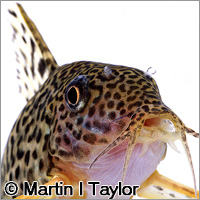Copycat(fish) shed new light on mimicry
There may be many more species of catfish swimming in South America's streams than previously suspected, a new study suggests. Writing in the journal Nature, scientists from Brazil and the UK explain that many communities of apparently identical fish in fact contain a number of species that have evolved to look the same. The findings have important implications for conservation, as many South American waterways are under threat from deforestation, damn construction and other activities. South America's streams teem with numerous species of catfish, most of which belong to the genus Corydoras. Corydoradinae catfish display a range of patterns, including blocks of colour, bright spines, patches, bands, stripes and spots. At many sites shoals appear at first glance to be made up of just one species. However, closer investigation reveals that these communities actually comprise a number of different yet identically-marked species. These species share much in common; they are hunted by the same bird and fish predators. They also defend themselves in similar ways, with most species bearing retractable venomous spines, for example. The key to the research is a phenomenon known as Müllerian mimicry, in which noxious species that have the same predators adopt the same warning markings. This way, all species share the cost of 'educating' predators that they are not a good option for a tasty meal. However, questions have been raised as to whether this form of mimicry may benefit some mimics more than others. In this study, the researchers discovered that communities comprising different catfish species are able to live together because although they share defence mechanisms and markings, they do not compete for the same resources. According to the researchers, in most of the groups of mimics studied, the species have 'diverged in terms of resource acquisition, but converged in spatial occupation and colour pattern.' 'Although appearing identical in terms of colour pattern, our in-depth assessments of genetic relationships, diet, body shape and colour patterns of the fish revealed that 92% of the communities we sampled comprised species that do not compete for resources,' explained Markos Alexandrou, a PhD student at the School of Biological Sciences at the UK's Bangor University and the lead author of the paper. 'This research highlights the hidden diversity and complexity found within neotropical freshwater ecosystems,' added project leader Dr Martin Taylor, also of Bangor University. 'Unfortunately these habitats are also under extreme pressure from human activities. According to Claudio Oliveira of the Universidade Estadual Paulista in Brazil, the findings have major implications for conservation. 'Besides the unknown biodiversity and interesting evolutionary system revealed by this study, it reinforces the urgent need to preserve and manage South American environments to avoid the loss of many species yet to be discovered and described,' he notes.For more information, please visit: Nature:http://www.nature.com/nature Bangor University:http://www.bangor.ac.uk
Countries
Brazil, United Kingdom



